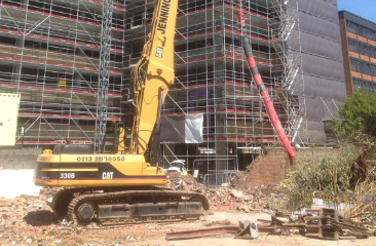
15 Apr How to minimise your demolition project’s effect on the environment
Minimising your demolition project’s effect or impact on the environment requires some common sense and adherence to laws put in place for the construction sector.
If you hire a professional firm like us, we will perform a survey to determine what measures should be put in place. Here’s some of those potential measures:
Asbestos
One of the biggest concerns with demolition projects, especially in the case of older buildings built before 1960, or buildings refurbished during this time, is asbestos. The most dangerous type of asbestos hasn’t been used in construction since the 60s but other types of asbestos have. The last asbestos to be banned was white asbestos which was used until 1999. All types of asbestos are known to cause cancer.
When solid and fused asbestos is harmless but when inhaled it is proven to cause serious, chronic, cancerous and non-cancerous respiratory disease.
This is a cause for concern where demolition is concerned because the demolition of a building containing asbestos will naturally unsettle the asbestos boards, causing them to break up and the asbestos fibres to become airborne. These fibres then travel in the wind with studies showing airborne fibres can travel over a mile.
If there is any reason at all to suspect a building may contain asbestos, an asbestos survey should always be performed prior to demolition. This will see a specialist team enter the building and search for any asbestos on site. If it is found, the asbestos must be removed as best as possible, to ensure the bigger demolition project doesn’t kick it up. Please note that this is an intrusive survey which will destroy the building innards.
Noise pollution
Demolition is a noisy business and this cannot be helped. But there are specific laws in place to prevent nuisance noise in the construction sector. These stipulate that demolition work can only be performed during these hours: Monday to Friday 8am to 6pm, and Saturdays 8am to 1pm. Noisy work is prohibited on Sundays and bank holidays.
Working close to streams and water
Working close to streams, rivers, canals, and other areas of water presents a unique demolition challenge: how to contain the dust, dirt and airborne particles that will naturally be kicked up. The only way to do this is to use the minimal amount of force required to get the job done. For example, working close to water, we might deconstruct by hand instead of by machine, or use blast charges to bring the building down fast.
Wildlife and agriculture
As demolition specialists we see it as our duty to preserve as best as possible the health and wellbeing of wildlife as best we can on site. For example, if we find birds nesting in a building set for demolition, we will work with the local authorities to build alternative nesting grounds for them. If we are working close to trees and bushes, we will not touch these, and we will do all we can to minimise disruption to any wildlife.
In terms of working close to farms and livestock, we abide by noise pollution laws and we will communicate with the farm owner to discuss their concerns. If they have any special requests, we will consider these and communicate them to the customer, or they can do that and we will action those concerns. A conversation we find is no hard thing and it can save a lot of trouble further down the line.
Site clearance and crushing
It is always important to clear sites thoroughly after demolition to rid them as best as possible from pollutants and manmade substances. As part of this, it is normal to provide an onsite crushing service. This makes the removal of brick, stone, timber, cement and other things much easier. It is also normal to sort materials and deliver them to recycling centres which we always recommend on every demolition project.


No Comments